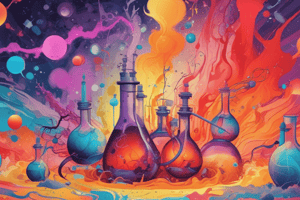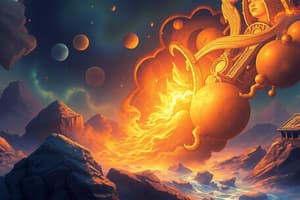Podcast
Questions and Answers
What occurs at the stage of chemical equilibrium in a reaction?
What occurs at the stage of chemical equilibrium in a reaction?
- The concentrations of reactants and products change continuously.
- The reaction ceases and no further changes occur.
- The reaction mixture is completely consumed.
- The rate of formation of products equals the rate of formation of reactants. (correct)
In the synthesis of ammonia, what is the relationship between nitrogen and hydrogen concentrations at equilibrium?
In the synthesis of ammonia, what is the relationship between nitrogen and hydrogen concentrations at equilibrium?
- All nitrogen is consumed before reaching equilibrium.
- Nitrogen and hydrogen concentrations remain constant. (correct)
- Nitrogen is produced at a greater rate than hydrogen is consumed.
- Hydrogen is always in excess at equilibrium.
What does the equilibrium constant indicate in a reversible reaction?
What does the equilibrium constant indicate in a reversible reaction?
- The ratio of reactant concentrations to product concentrations at equilibrium. (correct)
- The total amount of all substances involved in the reaction.
- The time taken to reach complete reaction.
- The rate at which products are formed.
What is true about the reaction A + B = AB at chemical equilibrium?
What is true about the reaction A + B = AB at chemical equilibrium?
Which statement accurately represents a characteristic of reversible reactions?
Which statement accurately represents a characteristic of reversible reactions?
What is the expression for the equilibrium constant Kp for the reaction 2NH3(g) = N2(g) + 3H2(g)?
What is the expression for the equilibrium constant Kp for the reaction 2NH3(g) = N2(g) + 3H2(g)?
Which of the following describes the conditions under which concentration constants (Kc) can be effectively used?
Which of the following describes the conditions under which concentration constants (Kc) can be effectively used?
How is the relationship between Kp and Kc expressed in terms of gaseous products and reactants?
How is the relationship between Kp and Kc expressed in terms of gaseous products and reactants?
What is a significant drawback of using activity constants (Ka) in equilibrium calculations?
What is a significant drawback of using activity constants (Ka) in equilibrium calculations?
What does it imply when the equilibrium constant K is much greater than 1?
What does it imply when the equilibrium constant K is much greater than 1?
What does the law of mass action state about the rate of a chemical reaction?
What does the law of mass action state about the rate of a chemical reaction?
For the reaction represented as aA + bB = cC + dD, which of the following provides the correct equilibrium constant expression?
For the reaction represented as aA + bB = cC + dD, which of the following provides the correct equilibrium constant expression?
Which of the following best describes a heterogeneous equilibrium?
Which of the following best describes a heterogeneous equilibrium?
What is the significance of the phases of reactants and products in equilibrium constant expressions?
What is the significance of the phases of reactants and products in equilibrium constant expressions?
For the given reaction Fe2O3 (s) + 3H2O(l) = 2Fe2+ (aq) + 6OH- (aq), what is the correct equilibrium constant expression?
For the given reaction Fe2O3 (s) + 3H2O(l) = 2Fe2+ (aq) + 6OH- (aq), what is the correct equilibrium constant expression?
What occurs when a chemical reaction reaches equilibrium?
What occurs when a chemical reaction reaches equilibrium?
In the equilibrium constant expression K = [AB] / [A][B], what does the K value indicate?
In the equilibrium constant expression K = [AB] / [A][B], what does the K value indicate?
Which of the following statements is true regarding the equilibrium constant K?
Which of the following statements is true regarding the equilibrium constant K?
Flashcards are hidden until you start studying
Study Notes
Chemical Equilibrium
- Equilibrium is a state in a chemical reaction where the composition of the mixture remains constant, despite ongoing reactions.
- The rate of formation of products equals the rate of conversion back to reactants.
- Example of a reversible reaction: A + B ⇌ AB.
- Synthesis of ammonia: N2(g) + 3H2(g) ⇌ 2NH3(g) reaches a steady state before full consumption of reactants.
Law of Mass Action
- The rate of a chemical reaction correlates directly with the concentrations of the reactants.
- Introduced by chemists Guldberg and Waage in 1863.
- For a reaction A + B ⇌ AB, the forward and reverse rates can be expressed as:
- Rate of forward reaction: Ratef = k1[A][B]
- Rate of reverse reaction: Rater = k2[AB]
Equilibrium Constant
- At equilibrium, Ratef = Rater, leading to the equilibrium constant expression:
- K = k1/k2 = [AB]/([A][B])
- General expression for reaction aA + bB ⇌ cC + dD is:
- K = [C]c[D]d / [A]a[B]b
- Phases must be indicated: gas (g), liquid (l), solid (s), aqueous (aq).
- Concentrations of solids and pure liquids are considered constant.
Types of Equilibria
- Homogeneous Equilibrium: All reactants and products in the same phase (e.g., gases). Example: Haber process.
- Heterogeneous Equilibrium: Reactants and products in different phases (e.g., solids and gases). Example: CaCO3(s) ⇌ CaO(s) + CO2(g).
Kinds of Equilibrium Constants
- Concentration constant (Kc): Expressed in moles/liter, sensitive to ionic strength.
- Partial pressure constant (Kp): Used for gaseous reactions, expressed with partial pressures.
- Example: For 2NH3(g) ⇌ N2(g) + 3H2(g), Kp = (PN2 * PH2^3) / (PNH3^2).
Relationship between Kc and Kp
- For ideal gases, P = MRT, linking pressure to molarity.
- Kp and Kc are related by the formula:
- Kp = Kc (RT)Δng
- Δng represents the change in the number of moles of gaseous products minus the moles of gaseous reactants.
Activity Constants
- Activity constants (Ka): Express activities to represent true concentrations across all ionic strengths.
- Ka can be derived from thermodynamic data.
- The general significance of the equilibrium constant K:
- If K >> 1, reaction products dominate the mixture.
Studying That Suits You
Use AI to generate personalized quizzes and flashcards to suit your learning preferences.




